
| Home | Butterflies | Dragonflies | Birds (media) | Flora & Fauna (media) | Observations | Species | Mexican Species |
| Download Checklists | Links | My 5 Chickens | Other Photos | The Birding Program | About | GPS | News |
Bird photos, sounds and videos
| Brant (Branta bernicla) Ducks, Geese and Waterfowl (Anatidae) | |
| Knortegås ~ Ganso de Collar ~ Prutgås | |
|
Hide text
Most obvious distinction between adult and first years is that the adults have upper wing coverts without broad white edges, thus, a more uniformly looking bird. Also, it has strong whitish patches on the side of the upper neck, lacking in the young plumage.
|
|
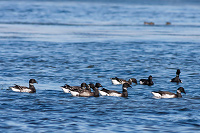
|
1387
(1 photos)
2010-11-14 Bahía de San Quintín (bcn), Mexico Subspecies: nigricans Young and adult birds. The adults, two birds in front to the right, don't show white edges to the wing feathers. The young birds, first calendar year, acquire the neck spot from early winter, and look like adults in this respect. |
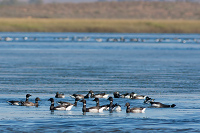
|
1388
(1 photos)
2010-11-14 Bahía de San Quintín (bcn), Mexico Subspecies: nigricans Adult and young birds. Likely, same group as 1387. |
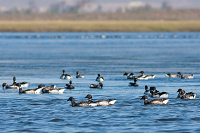
|
1389
(1 photos)
2010-11-14 Bahía de San Quintín (bcn), Mexico Perhaps the picture is misleading, but it looks like a young bird still without the neck spot. Checking all my photos from this trip, it appears that almost all the young birds have acquired the neck spot at this date, so probably a bit unusual, this bird. |

|
1390
(1 photos)
2010-11-14 Bahía de San Quintín (bcn), Mexico Subspecies: nigricans Large neck spots, the dark on the belly continuing well toward the lower rump, and the clear white flanks on almost all birds are good indications that these birds are of black-bellied origin. However, one bird below in the middle group to the right shows a drabber coloration to the underside, but this is probably due to variation, and not a hint to start speculating if the bird could be a 'gray-bellied', though these probably could be found here among the black-bellied. |
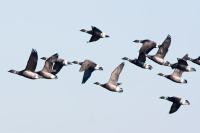
|
1391
(1 photos)
2010-11-14 Bahía de San Quintín (bcn), Mexico Subspecies: nigricans All classical black-bellied and apparently all adult birds. |
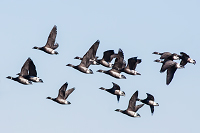
|
1392
(1 photos)
2010-11-14 Bahía de San Quintín (bcn), Mexico Subspecies: nigricans Also here, all typical black-bellied adult birds. |

|
1393
(1 photos)
2010-11-14 Bahía de San Quintín (bcn), Mexico Subspecies: nigricans Bahía San Quintín is an important wintering site for the black-bellied brants. Under my short visit I counted some 11000 birds, but I would expect more birds to show up later in the winter - depending on how cold it gets further north. |
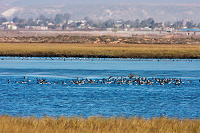
|
1394
(1 photos)
2010-11-14 Bahía de San Quintín (bcn), Mexico Subspecies: nigricans The Brants, and other waterbirds,find good conditions here in the shallow waters well protected from the Pacific by a long landhead on the outside. |
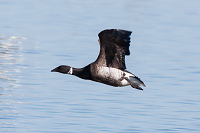
|
1396
(1 photos)
2010-11-15 Bahía de San Quintín (bcn), Mexico Subspecies: nigricans Same as 620. |
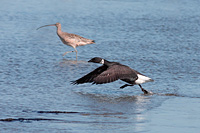
|
620
(1 photos)
2010-11-15 Bahía de San Quintín (bcn), Mexico Subspecies: nigricans Adult black-bellied. The adult wing without white wing bands isobvious here. |
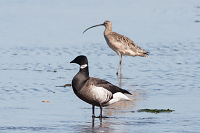
|
1395
(1 photos)
2010-11-15 Bahía de San Quintín (bcn), Mexico Subspecies: nigricans Same as 620. Classical adult black-bellied, though both back and belly could appear darker. But variation occurs. |
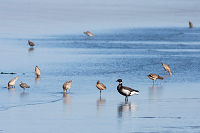
|
1397
(1 photos)
2010-11-15 Bahía de San Quintín (bcn), Mexico Subspecies: nigricans Same as 620. Here with Marbled Godwits and Willets. |
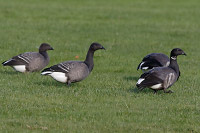
|
2364
(11 photos)
2016-11-13 Dragør Kommune, Denmark Subspecies: bernicla Family flock - 2 adults and 4 young birds. The age field marks are very clear here: Adults with the heavy neck patch, whitish vertical lines toward the flank and uniformly colored gray wing coverts. The only birds I saw this year. Apparently a late family stopping over for a while to forage before heading further on toward the Channel region. Dark-bellied because of the dark belly and flank, and dark between the legs. The only type of Brant regularly seen in the eastern part of Denmark. |
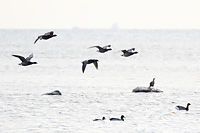
|
3199
(4 photos)
2019-10-14 Kongelundsområdet, Denmark Subspecies: bernicla Adult birds with white neck patch and juveniles without it and with much less flank barring. Dark-bellied bernicla is the common subspecies in this part of Denmark. Light-bellied hrota normally only seen in Jutland, and even though the distance is as little as a few hundred kilometers, this separation is a very consistent habit. A few hundred birds were roosting this day. |
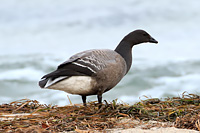
|
3213
(3 photos)
2019-11-01 Amager Strandpark, Denmark Subspecies: bernicla Young bird with white tips to wing coverts and back feathers plus no white neck patch. Also the uniformly dark belly and flanks without indication of vertical streaking is an age mark. 4 or 5 were lying on the water and this one joined them when yet another notoriously ignorant dog owner chased off the bird. |
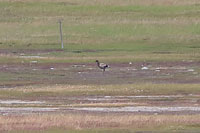
|
3457
(4 photos)
2020-07-11 Kalvebod Fælled, Denmark Subspecies: [hrota (Atlantic)] Pale-bellied with clear demarcation between neck and breast. Rare visitor to this part of Denmark. Rare |
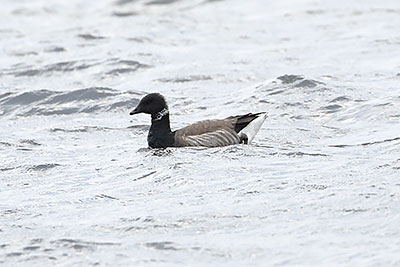
|
3645
(2 photos)
2021-10-28 Kalvebod Fælled, Denmark Subspecies: bernicla Adult. Dark-bellied. |
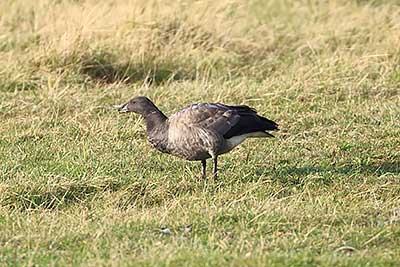
|
3646
(3 photos)
2021-10-30 Kalvebod Fælled, Denmark Adult. |

|
3638
(2 photos)
2021-10-31 Kalvebod Fælled, Denmark Subspecies: bernicla Adult. Aged by lack of whitish edges to the coverts. I'm not sure if the different nuances of the coverts is a simple reflection of worn vs. new adult feathers or if it indicates that it is young adult, 2cy bird. The weak necklace could indicate the latter. A privilege, every year, to have few of these birds visiting and allowing one to come this close. |

|
3639
(2 photos)
2021-10-31 Kalvebod Fælled, Denmark Subspecies: bernicla Dark-bellied. Adult and first year. Probably family. |

|
4336
(2 photos)
2022-11-18 Kalvebod Fælled, Denmark Subspecies: bernicla Adult. The dike 100 meters north of Nordtårnet. A single bird limping and grassing on top of the dike. |

|
5397
(4 photos)
2023-11-18 Kalvebod Fælled, Denmark Subspecies: bernicla Adult. Dæmningen. A pair, likely. 1-3, 4. It's funny how a few birds each year decide to forage on the dike, close to human traffic. But of course also close to the safe haven of the open sea, if a quick retreat should be necessary. |